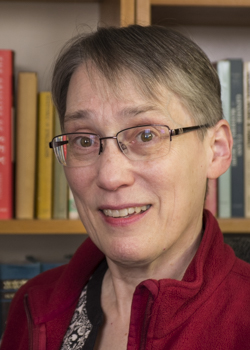Laughing Histories: Historian’s book chronicles the evolution of laughter
Laughing Histories: Historian’s book chronicles the evolution of laughter
What’s in a laugh? There may be more than you think.
Laughter packs a lot of social power, according to historian Joy Wiltenburg. Yet, it is, she says, “only written in air,” so researching its history is particularly challenging.
 Wiltenburg (at right), however, found a way. She’s the author of Laughing Histories: From the Renaissance Man to the Woman of Wit, published last month by Routledge.
Wiltenburg (at right), however, found a way. She’s the author of Laughing Histories: From the Renaissance Man to the Woman of Wit, published last month by Routledge.
“Initially, I thought, ‘how on earth do you do this?’ Wiltenburg chuckles. “People laugh a lot, but the vast bulk of laughter goes unrecorded. Most laughter disappears from memory, but some makes such an impression that it is written down. I looked for laughter where it lived.”
A professor of history who recently retired from Rowan University’s College of Humanities & Social Sciences, Wiltenburg spent a decade carefully researching accounts of laughter by early modern Europeans to try to answer some questions about the role laughter plays in society.
Among them: How did social rules constrain laughter? Did the highest elites laugh less than others? How did laughter play out in relations between the sexes? Is there change over time in how and when people laugh? And what about our own laughter, which we perceive as natural and spontaneous? Has it, too, been historically conditioned?
'Laughter is powerful'
“For all its seeming frivolity, laughter is powerful. It disrupts the ground of social encounters, creating shifts of meaning that cannot be accomplished with serious modes of speech and behavior. This power makes it a significant mode of social negotiation,” writes Wiltenburg, who began research on Laughing Histories, her fourth book, after completing Crime and Culture in Early Modern Germany (2012, University of Virginia Press), which examined the rise of sensationalist crime reporting.
In Laughing Histories, Wiltenburg argues that laughing “appears as a mediator of social power—whether in personal self-assertion, the formation of social bonds, the undermining of hierarchies, or the enforcement of customary rules.”
The early modern era is an important one in the history of laughter, according to Wiltenburg, a scholar of the social and cultural history of early modern Europe. Modern readers may be surprised at the strong strain of negativity about laughter in Western Christian thinking, Wiltenburg says.
“Nearly everyone nowadays approves of laughter. Not only is it fun, but it is widely thought to be good for you. This has not always been so. It was the period between 1500 and 1800 that saw a gradual shift toward modern, more positive views of laughter,” Wiltenburg explains.
Revealing moments of laughter in history
Combing through diaries, letters and court records, Wiltenburg’s book focuses on individual case studies to illustrate different types of laughter and how laughter has evolved. In the process, she found revealing moments of laughter…from the top of courtly society to the man and woman in the street.
While artisans made fun of their betters and each other, royals used laughter for political purposes, according to Wiltenburg. Queen Elizabeth of England, for example, used jokes to deflect proposals of marriage she wanted to resist.
Meanwhile, Renaissance artist Benvenuto Cellini, known for his arrogance, used laughter to intimidate others—a style that confirmed in Wiltenburg’s research the negative potential of laughter. His contemporary and opposite, Swiss physician Felix Platter, experienced a different kind of laughter that bound people together, according to Wiltenburg.
In courtly laughter, exhibited by French aristocrat Madame de Sévigné and her circle, “there were demands for sophisticated wit and self-control, yet also some cutting and exclusive laughter that closed the circle against outsiders,” Wiltenburg says.
Challenging gender stereotypes, negotiating social place
Her research found women using laughter and humor to challenge gender stereotypes, while all people used it in negotiating their social place. The English diarist and naval administrator Samuel Pepys was “a connoisseur of laughter” who laughed enthusiastically and inclusively with people regardless of social status or gender. Yet, he used laughter for the purposes of social advancement, Wiltenburg notes.
Laughter, she adds, “has always been a powerful social agent. Its nature and uses have been contested and evolving.
“Early modern laughers show us both the power of laughter and its changing fortunes in different contexts,” she continues. “We can trace to the early modern period the modern high valuation of laughter and sense of humor, now a staple of social approval from casual acquaintance to life partner.
“Laughter has risen steadily in social approval since the 18th century. People have always enjoyed laughter in everyday life, but in the modern age disdain for laughter has waned even among grouchy intellectuals.”
Wiltenburg hopes Laughing Histories makes readers think more deeply about the origins of laughter while inspiring historians to conduct further study on its social implications. She’s particularly interested in the role laughter plays in gender relations.
“I hope the book brings to light some of the power of laughter that we might not notice, particularly when it comes to gender stereotypes,” says Wiltenburg. “Even within a given society, laughter differs according to social class and subculture.
“Laughter has not a history, but histories. I hope there will be more cross cultural studies of laughter.”